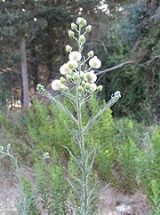
Conyza
Encyclopedia
Conyza is a genus of about 50 species of flowering plant
s in the family Asteraceae
, native to tropical and warm temperate regions throughout the world, and also north into cool temperate regions in North America
and eastern Asia
. The genus is closely related to Erigeron
(also known as fleabanes).
The species are annual
or perennial
herbaceous
plants, rarely shrub
s, growing to 1-2 m tall. The stems are erect, branched, with alternate leaves
. The flower
s are produced in inflorescence
s, with several inflorescences loosely clustered on each stem.
Many plant species of the Conyza genus are ruderal species and some have been found to be resistant to the herbicide Roundup, in some cases.
Flowering plant
The flowering plants , also known as Angiospermae or Magnoliophyta, are the most diverse group of land plants. Angiosperms are seed-producing plants like the gymnosperms and can be distinguished from the gymnosperms by a series of synapomorphies...
s in the family Asteraceae
Asteraceae
The Asteraceae or Compositae , is an exceedingly large and widespread family of vascular plants. The group has more than 22,750 currently accepted species, spread across 1620 genera and 12 subfamilies...
, native to tropical and warm temperate regions throughout the world, and also north into cool temperate regions in North America
North America
North America is a continent wholly within the Northern Hemisphere and almost wholly within the Western Hemisphere. It is also considered a northern subcontinent of the Americas...
and eastern Asia
Asia
Asia is the world's largest and most populous continent, located primarily in the eastern and northern hemispheres. It covers 8.7% of the Earth's total surface area and with approximately 3.879 billion people, it hosts 60% of the world's current human population...
. The genus is closely related to Erigeron
Erigeron
Erigeron is a genus of about 390 species of flowering plants in the family Asteraceae. The genus has a cosmopolitan distribution with the highest species diversity in North America, where 173 species occur....
(also known as fleabanes).
The species are annual
Annual plant
An annual plant is a plant that usually germinates, flowers, and dies in a year or season. True annuals will only live longer than a year if they are prevented from setting seed...
or perennial
Perennial plant
A perennial plant or simply perennial is a plant that lives for more than two years. The term is often used to differentiate a plant from shorter lived annuals and biennials. The term is sometimes misused by commercial gardeners or horticulturalists to describe only herbaceous perennials...
herbaceous
Herbaceous
A herbaceous plant is a plant that has leaves and stems that die down at the end of the growing season to the soil level. They have no persistent woody stem above ground...
plants, rarely shrub
Shrub
A shrub or bush is distinguished from a tree by its multiple stems and shorter height, usually under 5–6 m tall. A large number of plants may become either shrubs or trees, depending on the growing conditions they experience...
s, growing to 1-2 m tall. The stems are erect, branched, with alternate leaves
Leaf
A leaf is an organ of a vascular plant, as defined in botanical terms, and in particular in plant morphology. Foliage is a mass noun that refers to leaves as a feature of plants....
. The flower
Flower
A flower, sometimes known as a bloom or blossom, is the reproductive structure found in flowering plants . The biological function of a flower is to effect reproduction, usually by providing a mechanism for the union of sperm with eggs...
s are produced in inflorescence
Inflorescence
An inflorescence is a group or cluster of flowers arranged on a stem that is composed of a main branch or a complicated arrangement of branches. Strictly, it is the part of the shoot of seed plants where flowers are formed and which is accordingly modified...
s, with several inflorescences loosely clustered on each stem.
Many plant species of the Conyza genus are ruderal species and some have been found to be resistant to the herbicide Roundup, in some cases.
Selected species
The native range of each species is given; some are introduced elsewhere in the world.- Conyza aegyptiaca. Africa, southern Asia.
- Conyza ageratoides. Madagascar.
- Conyza blinii. China.
- Conyza bonariensisConyza bonariensisConyza bonariensis is a species of Conyza, found throughout the tropics and subtropics as a weed; its precise native origin is unknown, but most likely Central America or South America...
. Pantropical. - Conyza canadensisConyza canadensisConyza canadensis is an annual plant native throughout most of North America and Central America. Common names include Horseweed, Canadian Horseweed, Canadian Fleabane, Coltstail, Marestail and Butterweed.It is an annual plant growing to 1.5 m tall, with sparsely hairy stems...
. North and Central America. - Conyza japonica. Eastern Asia.
- Conyza laevigata. Mexico, Central and South America
- Conyza leucantha. Southern Asia, northern Australia.
- Conyza muliensis. China.
- Conyza perennis. China.
- Conyza stricta. China.
- Conyza primulifolia. Mexico, Central and South America.
- Conyza sumatrensisConyza sumatrensisConyza sumatrensis is an annual herb native to North America but naturalised worldwide.In certain countries the plant has started to exhibit resistance to herbicides....
. North America (despite the Latin name, not SumatraSumatraSumatra is an island in western Indonesia, westernmost of the Sunda Islands. It is the largest island entirely in Indonesia , and the sixth largest island in the world at 473,481 km2 with a population of 50,365,538...
). - Conyza ramosissima

